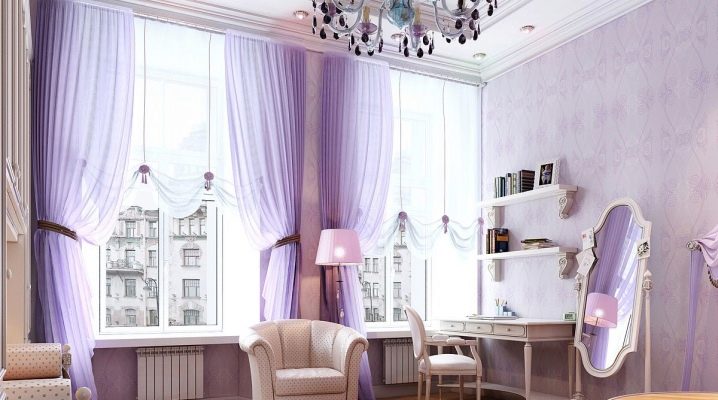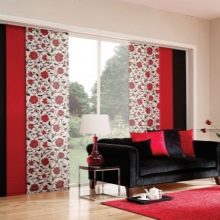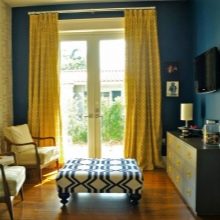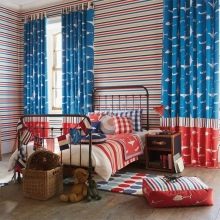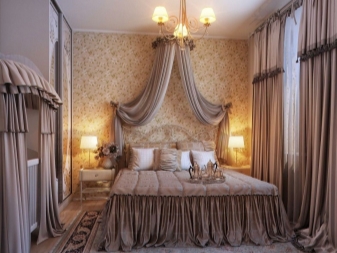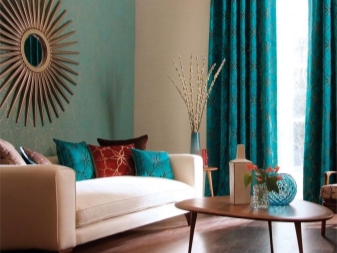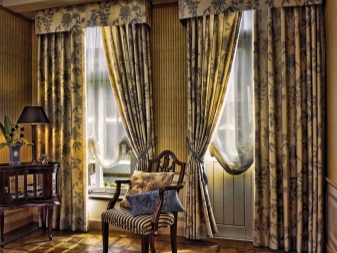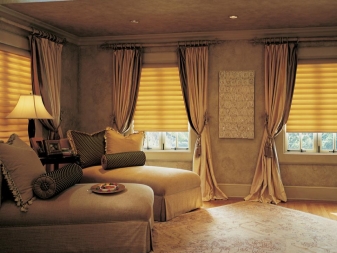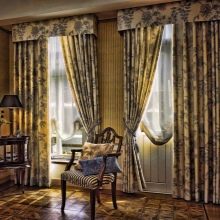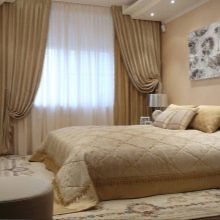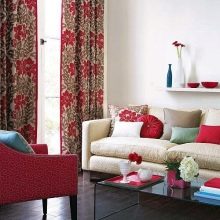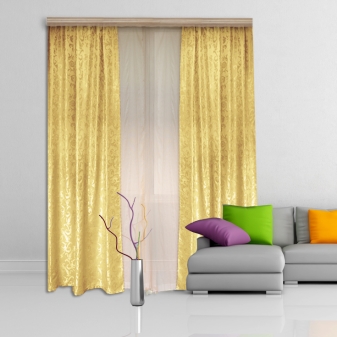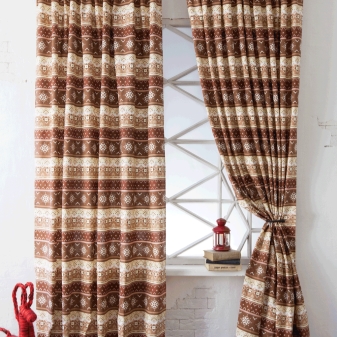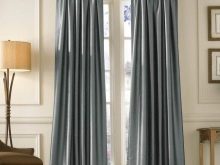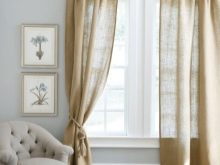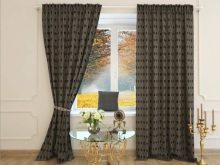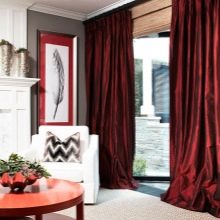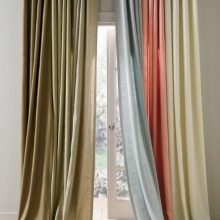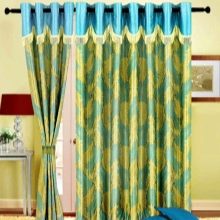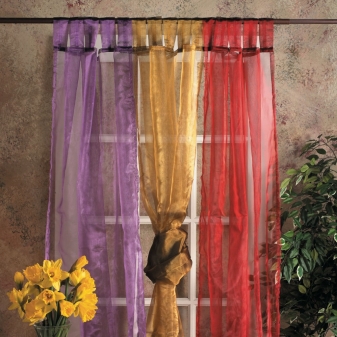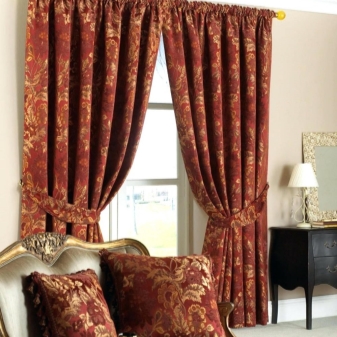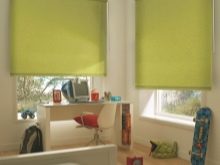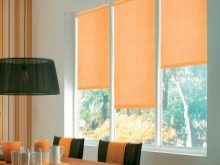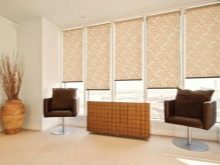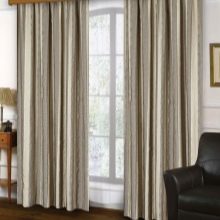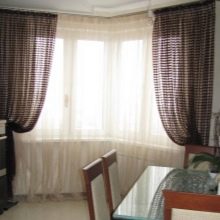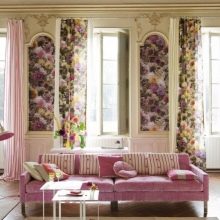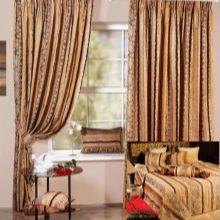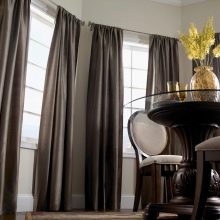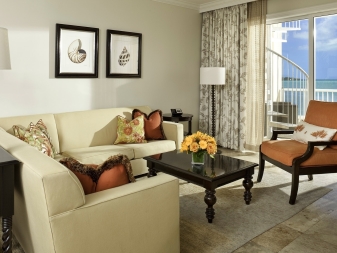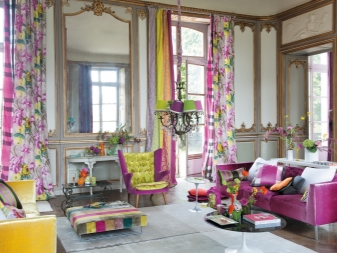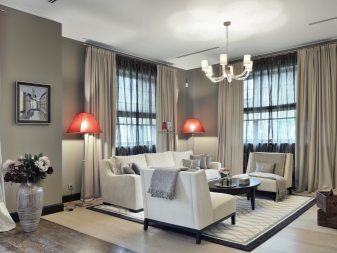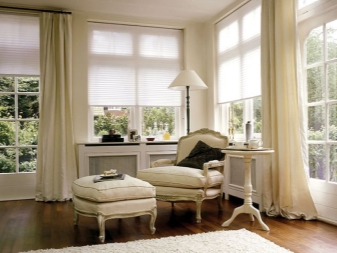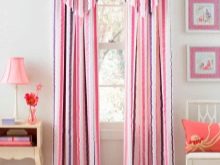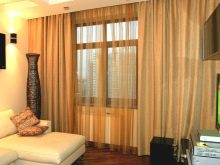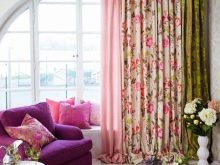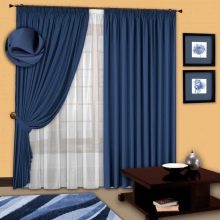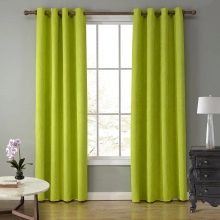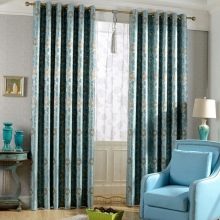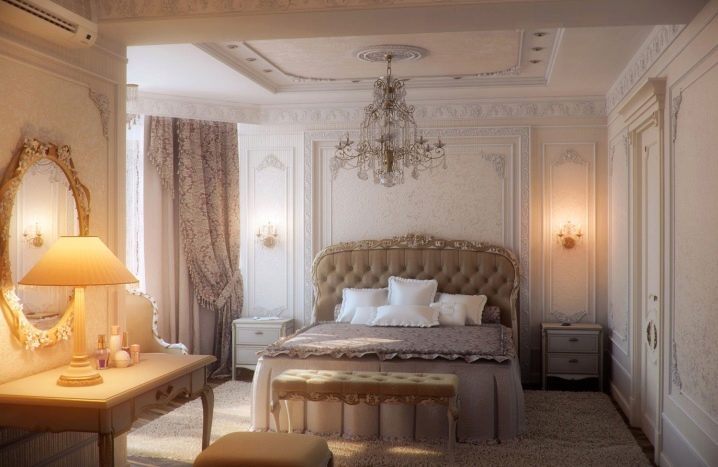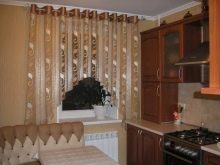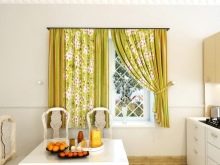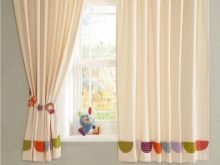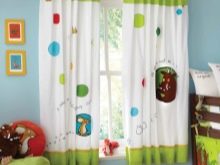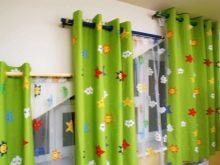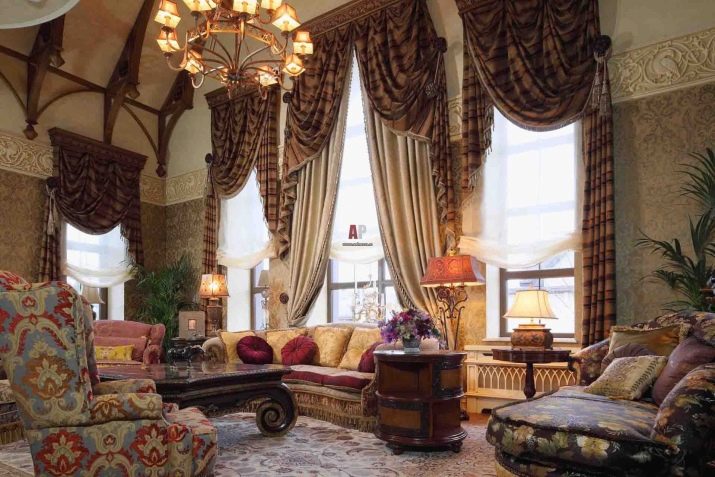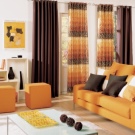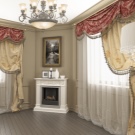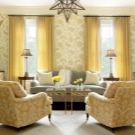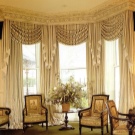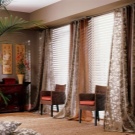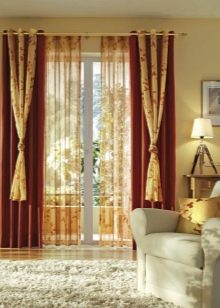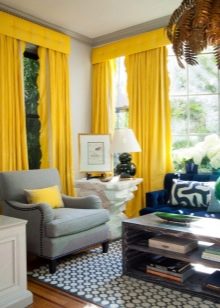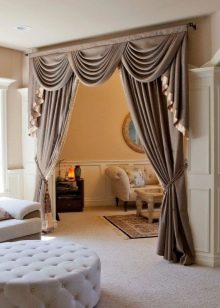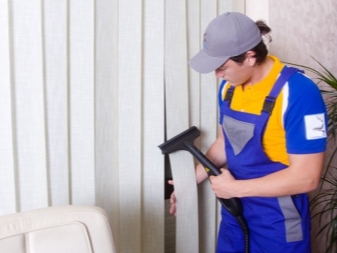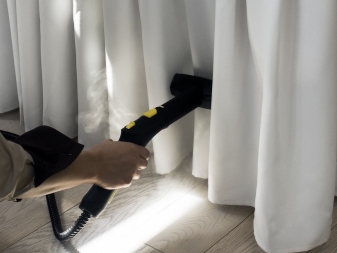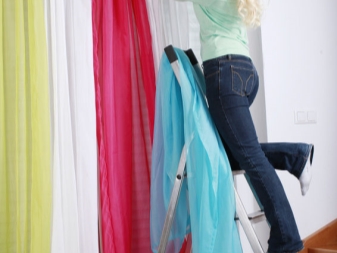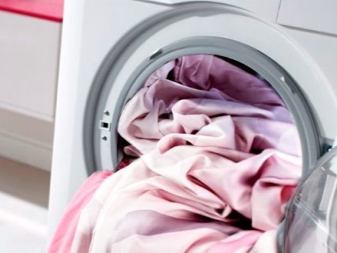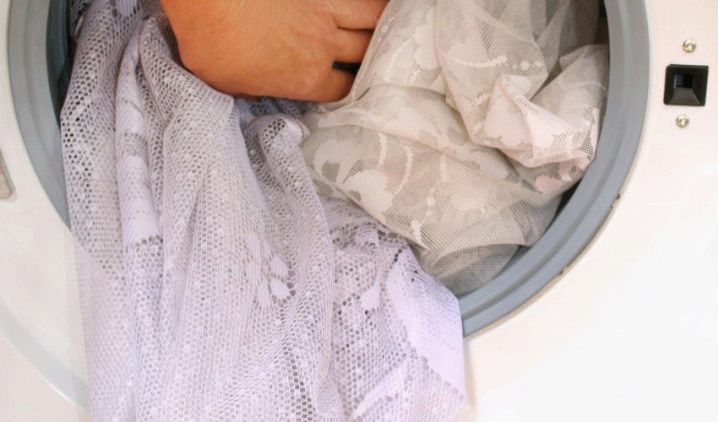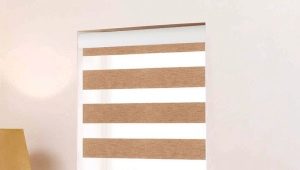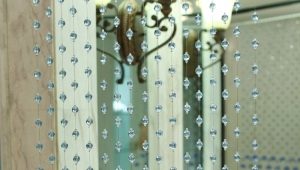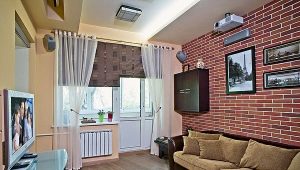Fabrics for curtains
In order to choose a suitable curtain fabric, it is necessary to understand its types and features. Some of them are suitable only for residential premises, others for non-residential ones. On how correctly matched the fabric depends on the appearance of the room, and the life of the curtains.
Requirements
In addition to the aesthetic appeal, the material for curtains should have a number of important differences:
- The fabric should last a long time. For some rooms, this moment is very important.
- It must fit the texture of the room, and also have a suitable weight so that it can be safely hung on the eaves.
- It should be easy to care for.
- It should not be flammable.
- The advantage is if the fabric does not absorb odors.
- Often it is required to create folds or bends on the fabric, in this case its elasticity is important.
- Should not fade in the sun (especially the curtains on the windows of the sunny side).
Based on the listed parameters, you should make your choice.
Depending on the room, a particular property of the fabric is important in different ways. For example, in order to decorate a bedroom, it is not at all necessary to worry about the resistance of the fabric to burning, but in the kitchen, on the contrary, this property comes to the fore.
In addition to the above, the composition of matter plays a significant role. Natural and artificial materials are laminated on a number of grounds and can also be used in different rooms. In some rooms, the preference is traditionally given to curtains made of artificial materials, for example, in the bathroom.
Properties and specifications
As mentioned above, the materials are divided into natural and artificial, depending on the composition. In addition to these two groups, there is a third - mixed fabrics. It includes materials, natural and artificial fibers, which are woven. Today, many designers recognize blended fabrics as the best choice.
By their qualities, artificial fabrics are sometimes even better than natural ones. They are easier to care for, they are strong and durable. However, natural have a number of advantages: they are hypoallergenic, do not electrify, look very luxurious, but not defiant.
The difference in price is sometimes quite large, but most often good artificial materials are close in price to natural ones.
The same applies to mixed fabrics: due to the advantages of the material, manufacturers sometimes “wind up” prices.
However, each of the individual types of fabric has different qualities. Fabrics differ in structure, fiber composition, pattern presence, and also in the form of weave. It depends on the strength of the fabric, as well as the presence or absence of the face and wrong side. Choosing a fabric for sewing curtains, pay attention to cloth (linen) and satin (satin). They differ from each other in the weave density: cloth cloths are rather dense and durable, and satin ones are smooth, soft, elastic.
Natural
Atural fabrics are popular despite numerous analogues among artificial materials. Curtains made of natural fiber hang in the bedroom, in the nursery, in a small living room. There are several popular types of fabric from which curtains are usually sewn:
- Cotton. Cotton fiber is used everywhere. From it weave both an independent cotton fabric and supplement it with other cotton threads.It is found in a variety of different configurations: they make thin cotton fabrics and rather dense cloths. Cotton collapses under the influence of sunlight, thinning and becoming less durable, so cotton curtains are recommended to be made on a lining. It is easy to wash; You can get rid of heavy dirt if you pre-soak the curtains. It is possible to iron cotton at the maximum heating of the iron.
- Satin. As a rule, satin is made of cotton and differs in the way weave. Due to this, it has a shiny smooth surface, but remains quite durable. According to its characteristics in many respects similar to cotton. Satin can be washed in a washing machine, and it should be ironed only on the wrong side.?
- Linen. It is a specially made fiber extracted from the plant of the same name. Linen cloths are completely different - from the thinnest veil material to dense upholstery. Flax has several advantages over its natural "brothers". In addition to being easy to care for, it does not accumulate static electricity and is well breathable and has the ability to disinfect the air, which makes the choice of this fabric ideal for bedroom allergies.Linen fabric has an interesting checkered texture due to the different thickness of the threads used to create the fabric. Since linen linen fade in the sun, it is advised to sew curtains of them on the lining. Iron flax at the maximum temperature of the iron.
- Silk. Silk is a thread that secrete caterpillars of Bombyx mori - silkworm butterfly. For the manufacture of fabrics for curtains are used mostly wild silk, which remains after the main production of dress fabric. Silk products are incredibly smooth, but at the same time durable. Silk has ideal fire characteristics because it does not burn, but melts under the action of fire. They wash the silk in the delicate wash mode with cold water, dry it, throwing it over the horizontal bar, and iron only completely dry matter without using steam with a non-hot iron. Under thermal effects, silk loses its luster and gloss.
- Wool. Animal hair (mostly sheep) is widely used in the manufacture of fabrics. Wool well protects the room from drafts, sunlight, extraneous noise, at the same time well passing oxygen.Wool products are also washed in a delicate wash with cold water, as it is prone to shrinkage. As a rule, ironing is not required.
Artificial
Artificial materials are easy to maintain, they do not fade in the sun, do not wear out and do not deform. There is a fairly rich choice of various artificial fabrics for sewing curtains that look quite decent on the windows. Basically, these are fabrics for curtains, but there are also curtains:
- Taffeta. This fabric reflects light very well, which is why designers love to use it in sunny rooms. Although the matter is rather dense, it drapes easily. Taffeta is a rather “capricious” material that requires delicate care: since it “sits down”, it is washed in cold water with gentle detergents.
- Viscose. Matter is very similar to silk, but it is more resistant to light and heat. Often the fabric is made with splashes of polyester, so that it is not wrinkled and easy to wash.
- Polyester. Contrary to stereotypes, high-quality polyester will last more than one year. It is very easy to maintain, wear-resistant, resistant to various environmental influences.It produces a huge range of products. A veil of polyester can be found as often as thick curtains. However, such curtains should be washed in a delicate wash mode with cold water and dried in a suspended state. As a rule, it is enough to go through the iron at stage 1-2 of heating to completely smooth out occasional creases on the fabric.
- Organza. Hard and spiny material is often chosen as curtains. Organza is matte and shiny. Both are draped easily, creating interesting large folds. Organza curtains are light enough, but do not fly away at the slightest breeze of the wind. To take care of them, it is enough to wash them in a typewriter, not wringing, and immediately hang on the eaves - the fabric dries very quickly.
- Jacquard. Fabric with a convex pattern to the color of the main canvas or another shade looks very interesting and elegant. Jacquard curtains are a modern alternative to brocade curtains. Most often, when decorating matter, natural themes are used. Care of jacquard curtains is best done with a vacuum cleaner and do not expose the curtains to wet cleaning.If the pollution is strong, you can include curtains in the dry cleaning.
For roll
Rolled curtains are traditionally made of artificial materials impregnated with a special composition that provides them with density. The interweaving of linen or polyester filaments will overwhelm on roller blinds very effectively.
Also, roller blinds can be made from natural materials, which are also impregnated with a sealing compound. Flax or satin are great options.
The choice of different models of curtains is extensive. However, they all share one thing: wear resistance, the ability to protect well from the sun's rays, resistance to external influences, ease of care.
Interesting modern materials
In addition to the traditional materials for window decoration, are used and completely new. It is worth looking at them in more detail:
- Grid. It is a knitted openwork fabric. The abundance of colors and weaving options made the net a favorite substitute for the already bored tulle curtains. Curtains from a grid can be picked up to any interior, both traditional, and fantasy modern.
- Reaper. Namuchuschie curtains of the header complement the interior of the hall, living room, bedroom, adding room grandeur and gloss. The material is extremely practical and easy to clean. The interesting structure of the fabric is characterized by an abundance of spontaneously created creases, which are not repeated, so it is better to make curtains out of the reaper.
- Gunny. This double-sided fabric has a very coarse rare weave texture. Gunny known to mankind since ancient times, but few mistresses use it in interior decoration. Popular styles nowadays, on the contrary, are credited with using coarse canvases, so that the matting firmly took its place in the list of current curtain materials.
Learn more about how to choose a fabric for curtains, you will learn from the following video.
We select, depending on the destination room
Not all rooms can have classic fabric curtains. Often only suitable option such as blinds. It is necessary to take into account the peculiarities of each of the fabrics before choosing it for the decor of the room.
Rooms are divided into residential and non-residential. Residential appropriate to add curtains or curtains, sometimes decorated with lambrequins. In non-residential rooms do not need this.In them, the curtains should not serve as decoration, but to cope well with their functional role: to protect the room.
With the help of curtains, you can add to the room of comfort, or, conversely, make it cooler; visually enlarge the room or reduce it; make the home a neat, modest look or defiant pompous.
So it’s important to think about what effect you want to achieve.
Living room
To decorate the hall, traditionally, thick curtain fabric is used in combination with light curtains. Material curtains and curtains should be of two colors, not necessarily contrasting. For light curtains fit shiny organza or veil with embroidery.
Mostly curtains are made from materials such as gabardine, jacquard, velvet, satin. Jacquard fabrics look very rich, solid, but not suitable for decoration of small rooms. The same applies to soft dense tissue. For example, velor canvases perfectly emphasize the size of a large living room, at the same time isolating it from excessive noise and drafts.
For lambrequin it is better to choose the same fabric from which the curtains were sewn. If this is not possible, select at least similar colors of materials.
It is ideal to have two sets of curtains for the hall: winter and summer. The summer set should be easy to maintain and should be able to wash such fabric in a typewriter. For example, flax, organza and similar fabrics are perfect for summer. For the winter, choose dense materials that will give a feeling of comfort and security.
Velvet fabrics with a special soft coating will be an excellent choice.
Bedroom
For the decoration of the windows in the bedroom is best to choose light natural materials. A person spends a third of his life in the bedroom, so it is very important that the curtains do not provoke health problems such as allergies (artificial material) or asthma (material that easily collects dust).
It is also possible to use curtains BlackOut. They are completely opaque due to the three-layer structure of the fabric, preventing the penetration of sunlight into the room. Blackout will appeal especially to those who work at night and have to sleep during the day.
Choosing curtains, look at the silk or linen, depending on the style of the room. Such options are expensive, but you can not save on the curtains in the bedroom. An interesting solution will be curtains of mesh, knitted from cotton yarn.They will protect your privacy, while not hindering the penetration of light.
The best fabrics for curtains in the bedroom are flax, cotton, silk, soft wool.
Kitchen
In the kitchen, on the contrary, it is not advised to buy curtains from natural matter. Synthetics are much more suitable if we are not talking about the space above the stove: then it is better to choose linen roller or roman blinds.
Short curtains of organza or polyester fit perfectly into the interior of the kitchen. They are very easy to care for, so that they can easily withstand frequent washing, and in which case they can be easily replaced with new ones without any special damage to the budget.
Short classic curtains with lambrequin of chintz will look cute and rustic. It is easy to wash the chintz, but it absorbs odors, so it is suitable only for those kitchens that are equipped with a good hood and ventilation system.
Children's
For the nursery, as for the bedroom, preference should be given to natural matter. It is advisable to choose fabrics with a pattern, so that it would be interesting for the child to look at the pictures on the windows.
Translucent fabrics will be a great solution. If you have such an opportunity, you can hang silk curtains.However, it is often a waste of money: the curtains in the nursery need to be washed quite often in order to completely get rid of dust and possible allergens.
A natural fiber organza or veil will compete with silk. It is much easier to care for them, they tolerate frequent washings and dry quickly, while the organza requires almost no ironing. The market has a huge selection of various colors and patterns. You can also order a photo print by selecting the image yourself.
We take into account the peculiarities of the style
To choose a suitable curtain, you need to remember about the style of the room. Be sure to rely on the overall design of the room.
You can make the curtains a central accent. To do this, select an unusual fabric and type of attachment. For example, a two-color bootie on the grommet will definitely attract attention.
Consider that not every fabric is suitable for a particular style. For example, satin or silk drapes are the hallmark of the Baroque style, but such curtains cannot be hung in a minimalist room.
Remember about flowers. The color of the fabric for curtains should be in harmony with the surrounding space.
To ensure that the fabric does not completely merge, if you decorate the window in a similar shade to the walls, choose curtains that are a tone darker or lighter than the base color.
Top manufacturers
Elite fabrics for curtains are made by European countries: Italy, Spain, England, Sweden other. English and Swedish are distinguished by a high price; Spanish matter is a bit cheaper, but not inferior in quality.
In recent years, Turkey pleases with its material. The rich choice and reasonable prices provided Turkish fabrics with an honorable place among the leading manufacturers.
Russia also offers a wide range of products. Unfortunately, prices for Russian fabrics are slightly lower than for foreign ones, but they are not always able to compete with foreign analogues in quality.
Care
Curtains do not always need total cleaning, sometimes it is enough just to put them in order in order to give a special atmosphere to the whole room.
Clean the curtains regularly. If you do not remove the dust on time, it can enter into the material, as a result of which it will forever lose a neat appearance.
To clean the curtains from dust, you can use a vacuum cleaner. Set it to minimum power and brush the curtains with a furniture brush.If you want to avoid the fact that the dust will be in the air, take a damp gauze and wind it on the end of the vacuum cleaner tube. Next, just handle the curtains. Regularly change the gauze to clean to avoid smearing dirt on the surface of the curtains.
Periodically heavy curtains need to be dry cleaned in the future.
On average, it is enough to carry out the procedure of professional cleaning every six months. Well, if in your arsenal a few sets of curtains. So you will save them from rapid wear, and from time to time you can refresh the interior.
If the curtains can be washed at home, we recommend that you purchase a special curtain cleaner. It, unlike the usual washing powder, will not damage the structure of the curtain fabric, will not clog it, as a result of which the material will remain breathable and will not lose shape.
Curtains should not be washed with other things, especially designed for wear. If any of this sheds, the curtains will be irretrievably damaged.
Whatever the manufacturer, do not use drumming or twist the fabric. Also, you can not use any devices to accelerate the drying of curtains: hair dryer,dryer and others. By allowing the material to dry naturally, you will negate the risks of damaging it. If you spoil the structure of the fabric, it will become very fragile and can easily tear in the future.
